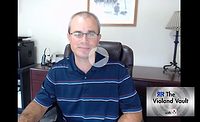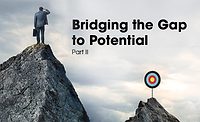The Delaware Water Gap is a sweeping valley almost a thousand feet wide, where the Delaware River cuts through a large ridge in the Appalachian Mountains, creating the eastern border of Pennsylvania and the western border of New Jersey. At some point in North American History, early settlers confronted this geological roadblock and had to decide whether to remain in the safety and security of the fertile grounds east of the gap or leave to explore the potential of new lands to the west.
During our professional careers, when faced with the realization that there is a difference between being successful and reaching our potential, we all experience this same phenomenon. The impact of this reality is compounded for business owners and entrepreneurs when considering their personal definitions of success and the potential of their businesses. We see this play out daily in small businesses across the country: business owners achieve levels of success in financial and operational performance that are commensurate to efforts brought forth by the hard work and determination they put in.
If these achievements are aligned with the vision for which their businesses were conceived, then a certain level of content reigns, and the business stalls until it eventually succumbs to the ever-changing influences of the competitive markets in which it plays. If it is not in alignment with a preconceived vision, most will strive for greater levels of performance and success by constantly seeking ways to adapt, evolve, and improve, while tirelessly growing at a rate that is equivalent to the owner’s level of stamina, competence, confidence, and comfort. In my opinion, these two scenarios are the exception, not the norm.
Because many small businesses fail within the first five years, I would dare to put forth the statement that most small businesses are born with the notion that a gritty entrepreneur saw potential in a product or service and fancied the idea of trying to make a living from it; nothing more. Thus, his/her definition of success is only as great as the desire to reap the benefits of a certain lifestyle. This sets a fluid and very fuzzy bar for expected levels of achievement in the business.
Evidence of this later scenario can be witnessed frequently, as the priorities of the business shift at the beck and whim of the owner, resulting in what we at Violand Management affectionately refer to as “Blurred Vision.” Sales are down, so we need to hire more salespeople. A new competitor comes to town, so we need to advertise more. Customers are complaining, so we need to replace the staff. Cash is tight, so we need to cut back overtime and stop professional development. This cycle of shifting priorities continues in what seems like a never-ending sitcom with a bad storyline.
When we consider best practices in management and leadership, it is often a wonder how some businesses got to where they are today despite their shortcomings in these areas. Nevertheless, they continue to survive by the muscle of their proprietors, ignorant to the potential yearning to be realized through the focus and execution of time-tested and proven business principles.
The result is akin to watching a musical prodigy play video games all day. Yes, they may be smart and talented, but what could they become if they put down the game controller and picked up their instrument more often? One could make a case that this comes down to determination or maybe even the work ethic instilled in us from an early age. We could also entertain the idea that potential is only viewed in the context of the industry norms in which the business operates, making the company slave to levels of accomplishment that are capped at a certain point. I would contest that it could be as simple as perspective.
When you work in a business, regardless of whether you are the owner, your perspective is relatively narrow. It is a street-level view of performance with traffic and lots of it. You become consumed by the daily grind and sucked into executing at a very tactical level. For the past nine years, I have had the distinct privilege of working with businesses in a capacity that has given me a unique perspective of our clients and their companies. Our founder, Chuck Violand, likens it to being perched on top a high-rise in the middle of a city. You can see things that those on the street level cannot. This includes risks to those below, along with potential that is not visible without this distinct vantage point.
Bridging the gap between previously achieved levels of success and true potential is a complex endeavor. Not because it is risky, but because it is uncomfortable. Consider the athletic coach who constantly pushes a young player during practice. This generally happens because the coach sees potential in the player that he/she may not see in themselves. The coach doesn’t bother doing the same with the less-talented athletes, but they ride the highly talented one like a thoroughbred racehorse, eventually getting the player to perform in ways he/she never imagined possible. This is anything but comfortable for the player, yet it can be extremely effective. The only limit is the player’s vision and perspective of what can be accomplished.
The same holds true in business; the difference being that the owner must be both the player and coach. They must constantly gain perspective on their ever-changing business while pushing themselves in ways that will most likely be extremely uncomfortable. This can also be done with the help of a consultant, peer, mentor, or trusted confidant. Rarely, however, is it accomplished alone. Regardless of the method of motivation or support, business owners who want to push the limits of their company’s success must constantly seek ways to bridge this gap between what is and what could be.
Every company has untapped potential that is obvious from the right perspective. The key to realizing this potential is understanding what the gap looks like and having the drive to explore it. After all, the risk is marginal. It requires little to no investment, catastrophic failure is highly unlikely, and the impact to the organization for striving to be the best you can be can only be positive.
I encourage every business owner reading this article to take a step back and look at your business while asking yourself the question, “where could we go from here?” If you give the question an honest look from the right perspective, I bet you will see potential in your business, your employees, and yourself that you never noticed before. Now, let’s get uncomfortable and bridge that gap.






Report Abusive Comment